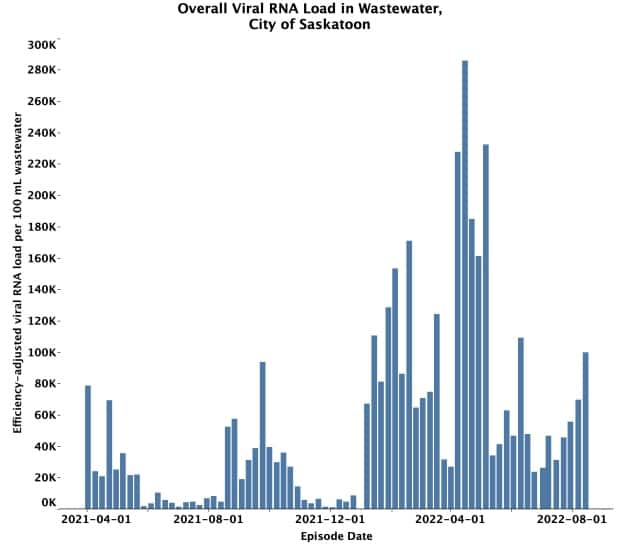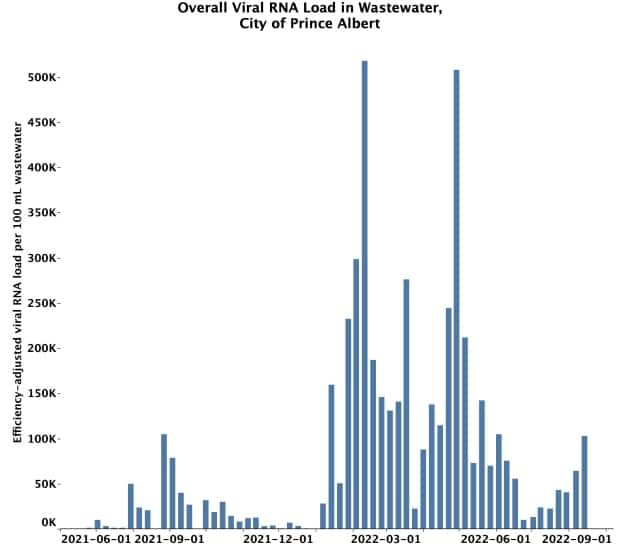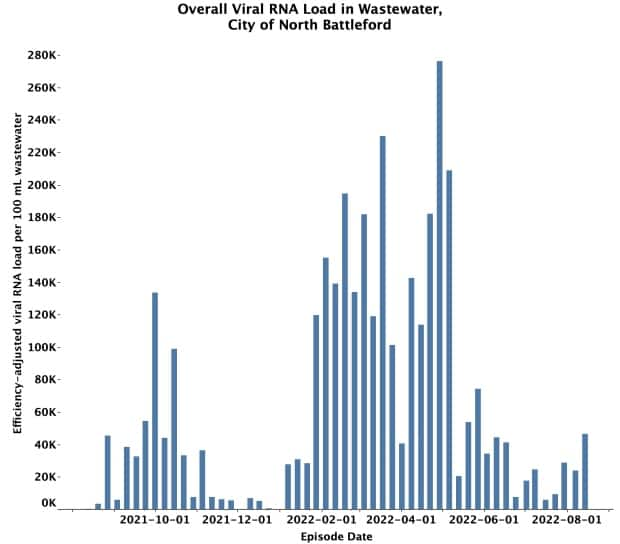Risk level moderate as Sask. COVID-19 wastewater levels continue to rise, says researcher

COVID-19 viral loads are rising once again in the wastewater of several Saskatchewan cities, according to new data released by a researcher at the University of Saskatchewan.
Since the summer of 2020, a small group of researchers at the University of Saskatchewan's Global Water Futures program has analyzed wastewater samples from Saskatoon, North Battleford and Prince Albert for traces of COVID-19.
Their results can help predict a rise or fall in positive cases seven to 10 days from the time they are taken, according to the Global Institute for Water Security.
"Since the values have increased week-over-week for the last month, we are defining this as a trend and we are likely in the middle of the seventh wave," John Giesy, the team's lead researcher and a toxicology professor, said in an email.
"The viral loads are defined as large, because they exceed the 10-week moving average."
Despite that, all three cities are still below the peak viral loads found earlier this year.
Currently the researchers classify the risk level for all three cities as yellow or moderate, said Giesy.
"We've been looking at a way of basically judging whether we're going into another wave or not," said Kerry McPhedran, associate professor at the department of civil, geological and environmental engineering at the University of Saskatchewan, in an interview with CBC News.
"This is also kind of matching what's happening in other parts of Canada, especially in Ontario, where they said that the seventh wave started at the beginning of July. We were a little bit later than that, as typical."
Levels increased in all 3 cities
Saskatoon data from the latest reporting period, which goes up to Aug. 10, showed a 43 per cent week-over-week increase in SARS-CoV-2 viral RNA load in the city's wastewater, according to Giesy.
This data is based on the averages of three daily measurements during the reporting time.
The measured viral load of around 100,000 gene copies per 100 millilitres of wastewater is the fourth consecutive rise since July 16, according to Giesy. The 10-week average is 56,000, he added.

The hike in viral RNA load indicates an increase in SARS-CoV-2 infections in the city, said Giesy.
Most people start shedding COVID-19 through their feces within 24 hours of being infected, the Global Institute for Water Security says on its website.
In Saskatoon the peak levels in April were about three times higher than the numbers in the most recent data, said McPhedran.
"If we go up 100 per cent now, we're at 200,000 [gene copies per 100 millilitres of wastewater], which is already close to those peaks that we've seen previously," he said.
"Based upon the statistics that we do … this would suggest that we're starting a seventh wave now."

Viral loads also jumped in Prince Albert's and North Battleford's wastewater.
In his email, Giesy said viral RNA load in Prince Albert climbed by almost 61 per cent in the reporting period up to Aug. 8, and sat at about 110,000 gene copies per 100 millilitres compared to a 10-week average of 45,000.
In North Battleford's wastewater, the SARS-CoV-2 viral RNA load rose by 93.2 per cent in the reporting period up to Aug. 6 compared to the weekly average of the previous reporting span, according to Giesy's email.

The recent data for the three cities "indicates that we're going to have a greater risk, if you go to events, of people having COVID," said McPhedran.
"Maybe people might suggest to wear masks again if you're going to events that have a lot of people…. We've had quite a few events going on. So a lot more interaction with people."
More testing of samples will follow this week
"These trends [in the cities] suggest that hospitalizations will be increasing, and possibly persons in ICU due to COVID-related disease will also increase," said Giesy in his email.
"The virus is still all of the Omicron variety with about half being fairly stable as BA.5. As yet we have not detected Omicron BA.75."
Giesy added that the data identifying the BA.5 has not yet met his "rigourous quality control standards," meaning he plans to re-run the samples for two of the days. As of Monday morning, the proportion of BA.5 was not based on the usual three-day weekly average, noted Giesy.
Updated data will be available on Tuesday, he said.
This does not affect the overall recent wastewater data in regard to viral loads detected, according to McPhedran.
Regina numbers down, but still high
The University of Regina has also released its most recent wastewater update on Monday.
It showed a small decrease of viral load levels compared to the previous testing period, but they are still high, according to the university.

 Yahoo Movies
Yahoo Movies 
